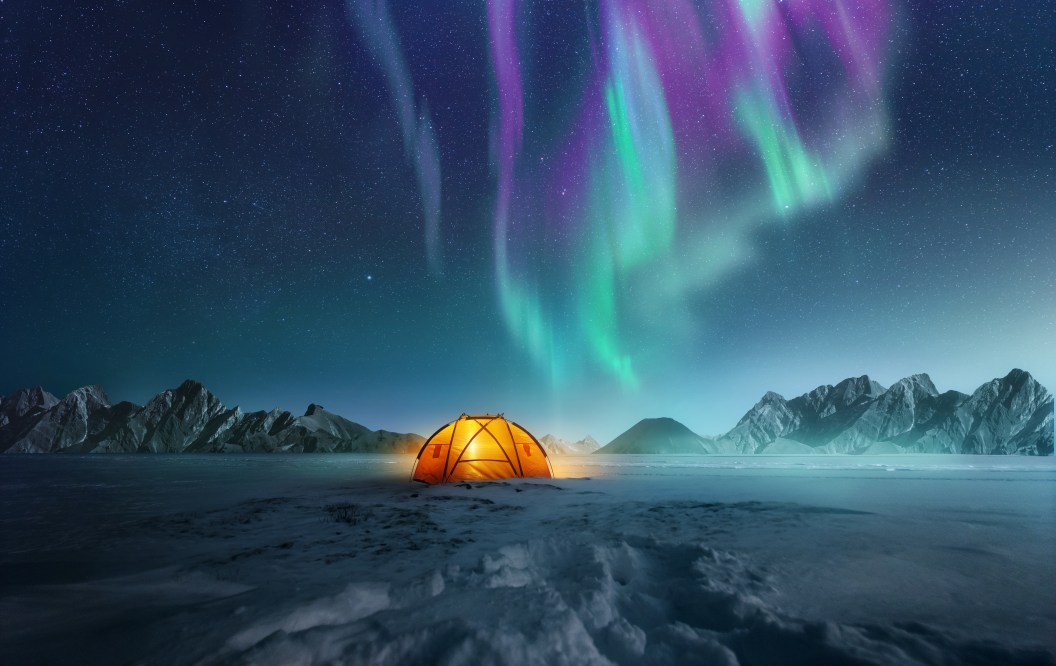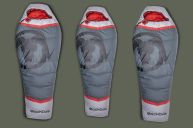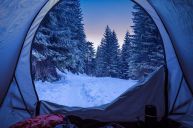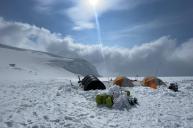Many of us love winter, and many of us love camping, but I live in the small section of the venn diagram alongside reindeer, polar bears, and a very special group of outdoors-folks: I love winter camping.
In addition to pitching a tent in snowy mountains for weekend trips, I've also lived and worked in Antarctica for several seasons (including a winter at the South Pole) and undertaken ski expeditions in the Arctic and other similar environments. Meaning: I've put a lot of different winter camping gear to the test and learning how to not be cold while camping, in the coldest of places.
If you love being outside in winter but are a bit apprehensive to dive into winter camping, I get it: Sleeping on the ground in freezing temperatures with a thin layer for walls and no creature comforts sounds tough. But winter camping has a certain magic to it, with rare, not-seen-by-many views of the outdoors in pristine white silence. And, as I've learned, all the challenges of cold-weather camping can be overcome with the right knowledge and setup.
In this guide, I've shared all my best tips and gear recommendations for how to take the chilly edge off of those cold winter nights outdoors and maximize camping comfort when exploring your chosen icy landscape.
The Essential Gear for Winter Camping
While summer is a bit more forgiving, not having the right gear when winter camping has much harsher consequences, from being uncomfortable at night to more severe issues like hypothermia or frostbite.
As someone who has camped far too many times in extreme cold, I can tell you: The following is the winter camping gear you'll need to bring with you.
1. Winter Camping Tent
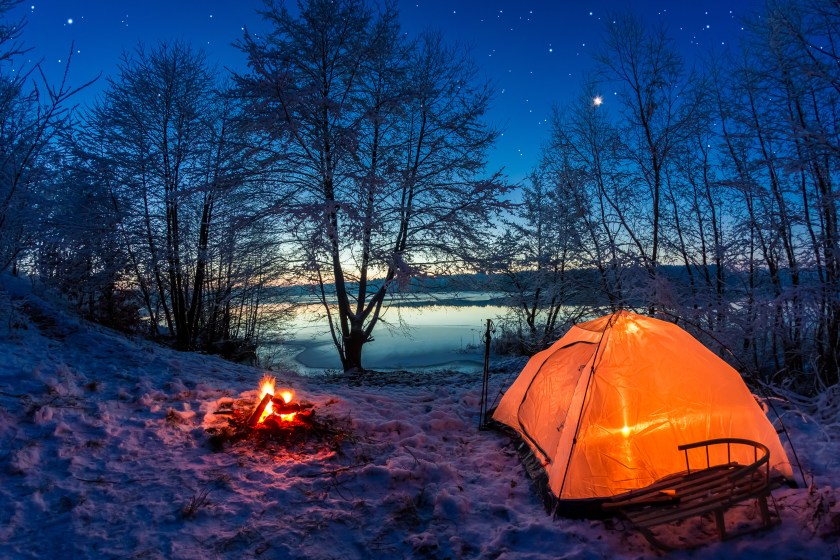
Getty Images, Shaiith
Double-wall, four-season tents are also better at keeping condensation at bay, which is crucial since that moisture that forms in your tent will turn to frost if there isn't adequate ventilation.
Also, while you can get away with a perfectly-sized tent in summer (i.e., two-person for two people) I would recommend sizing up for winter camping (e.g., a three-person tent for two people). You'll have more gear and more layers with you, so having extra space inside will be helpful. Bonus: If you can find a winter tent with a large vestibule, you'll have extra space to pull your gear out of the elements and score more space in the tent.
Our Top Picks
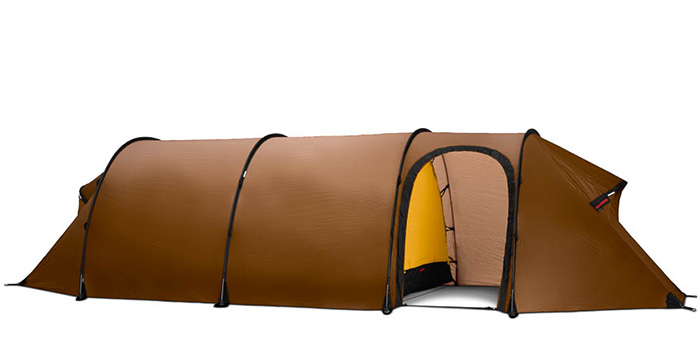
Hilleberg
My top selection for a winter camping tent, the Keron 3 GT is quite pricey but an extremely worthwhile investment. It has an excellent venting system to reduce frosty condensation inside; an extremely durable bathtub floor; and, when set up correctly, this tunnel-style tent can stand up to gnarly winds exceeding 50mph. This tent will last decades and protect you in any cold weather camping adventure, even a blizzard.
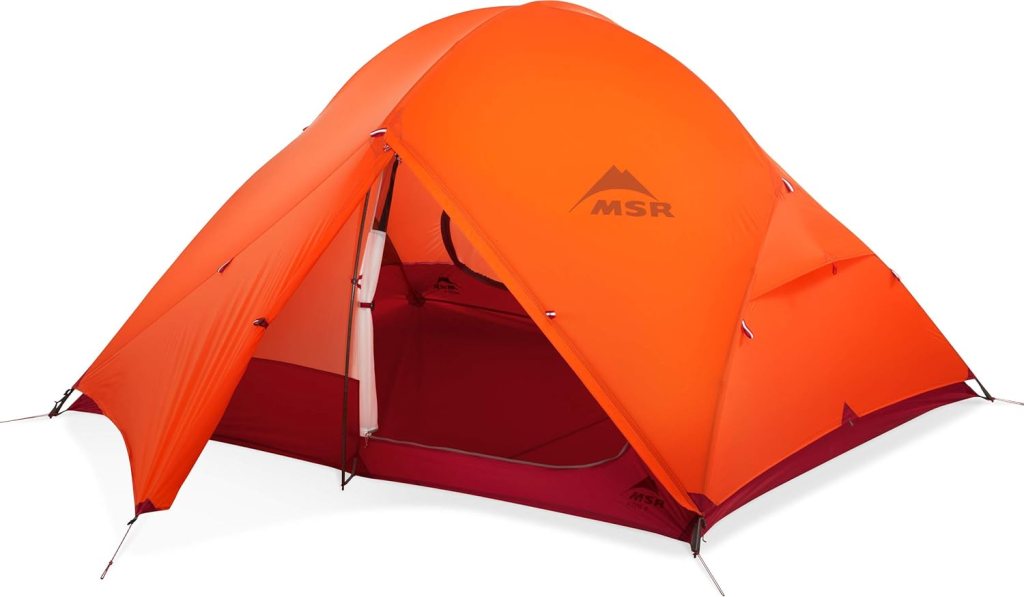
MSR
If you're looking for a sturdy, double-wall tent that isn't too heavy to lug, the MSR Access 3 is a great pick. In addition to being lightweight, it's made from 20-denier ripstop nylon and sporting Xtreme Shield polyurethane coating, so it can stand up to lighter winter conditions, including wind and temperatures below freezing. However, I wouldn't recommend it for extremely heavy snow or wind; there are sturdier tents on the market designed for more difficult weather.
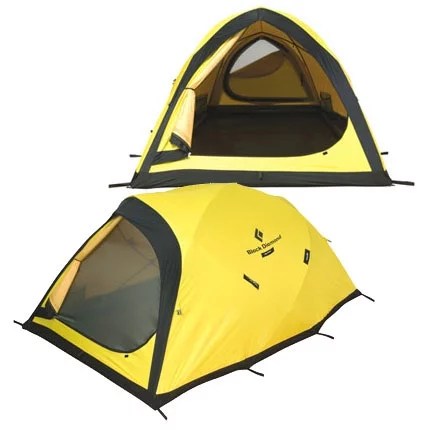
Black Diamond
If you're looking for a single-wall tent that can stand up to winter, the Fitzroy is a great choice: This tent is unbelievably storm-resistant and handles condensation better than other 4-season single-wall tent models. That sturdiness and reliability comes at the cost of weight: This tent is heavier than other single-wall models. But one major benefit is you can set it up from the inside to get out of the cold faster. (Pro trip: Practice before you take it out in a blizzard.)
2. Sleeping Bag
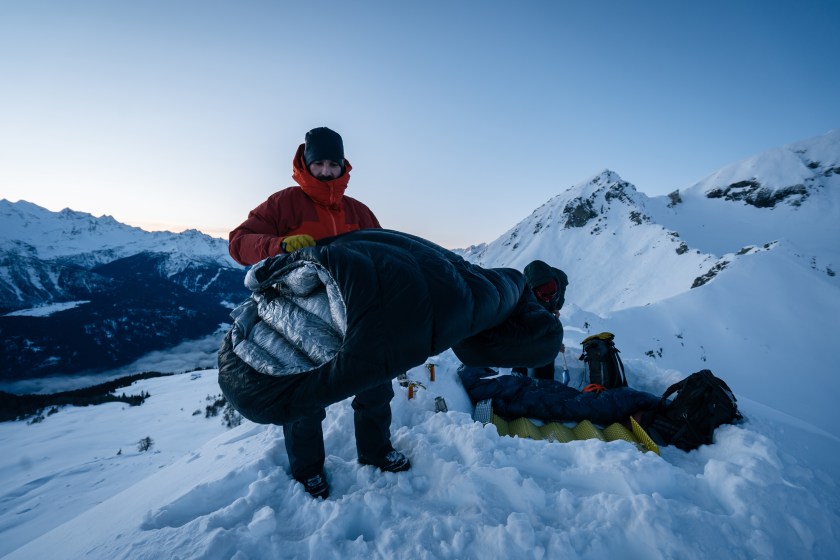
Getty Images, AscentXmedia
For winter camping, look at the "comfort rating," not the "extreme temperature rating." You want a sleeping bag with, at minimum, a comfort rating equivalent to what your weather forecast predicts. However, I'd strongly recommend choosing a bag rated 10-20 degrees colder than what you're expecting. You'll be happy if all goes as planned—and extra happy if you run into harsher weather than what's forecasted.
For insulation type:
- Down is warmer and lighter but it's essentially useless if it gets wet.
- Synthetic sleeping bags are heavier but they keep you warmer when wet.
Personally, if I'm going somewhere extremely cold and relatively dry, I always take a down bag. But if the temperatures aren't as extreme, I'm going out for a longer time (think two weeks or more), and/or the conditions are fairly wet, I'd opt for a synthetic sleeping bag.
The shape of your bag is important for heat retention as well as comfort. A mummy bag is going to keep you the warmest in below-freezing temps because it leaves less area for the warm air around you to escape and be replaced with colder air. If you're not going to be in extremely low temps and you prioritize comfort above all else, a quilt will allow you to stretch out while keeping most warm enough.
You can also double-layer your sleeping bag system to increase warmth. The ideal set-up: Use a down bag inside a synthetic bag or quilt. This lets you maximize the warmth you feel at night and minimize the frost that builds up on your down sleeping bag (which won't be as warm when that frost melts and gets it wet).
Our Top Picks
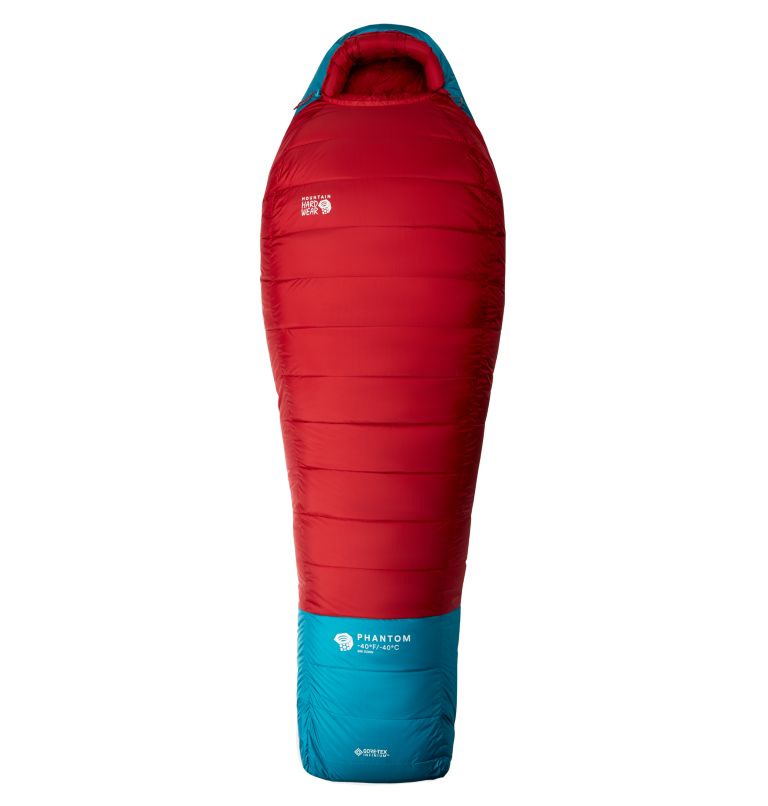
Mountain Hardware
My personal choice for all my winter adventures, the Phantom sleeping bag comes in different temperature ratings depending on your adventures ahead and are waterproofed with Gore-Tex so they stay drier longer than other down sleeping bags, even when the condensation starts to build. This bag is comfortable and roomy, minimizing the feeling of being confined in a mummy bag while also maximizing protection from the elements.
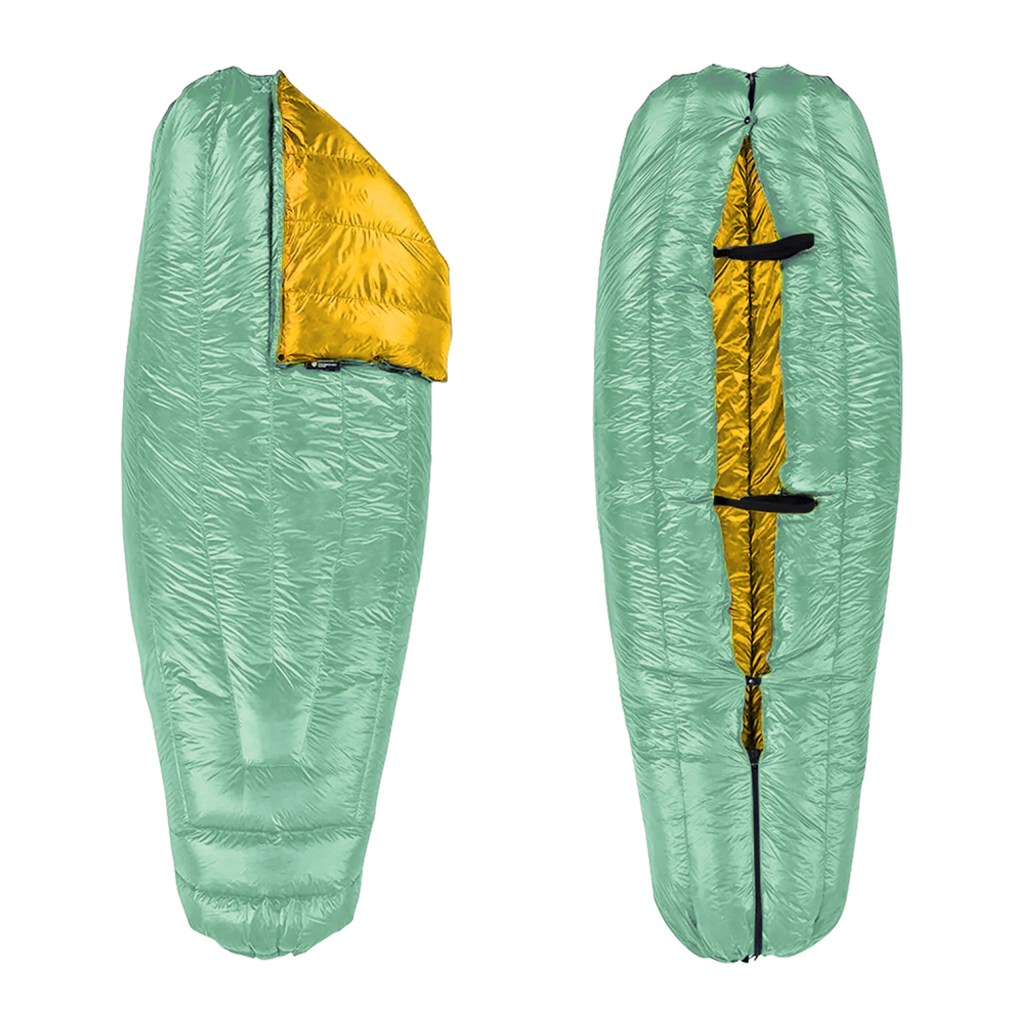
Enlightened Equipment
If you sleep warm, tend to be a stomach sleeper, or want to double up for extra warmth, you'll be happiest with a more comfortable quilt for winter camping. The 0-degree Enlightened Equipment quilt has kept me warm in temperatures in the teens with light wind, and, with zips and snaps, it converts into an excellent bag when the temps are a bit colder. It is completely customizable (length, width, temperature rating, colors, fill, etc.) with awesome color options, and there is even a synthetic version if you want something that can withstand moisture a bit better.
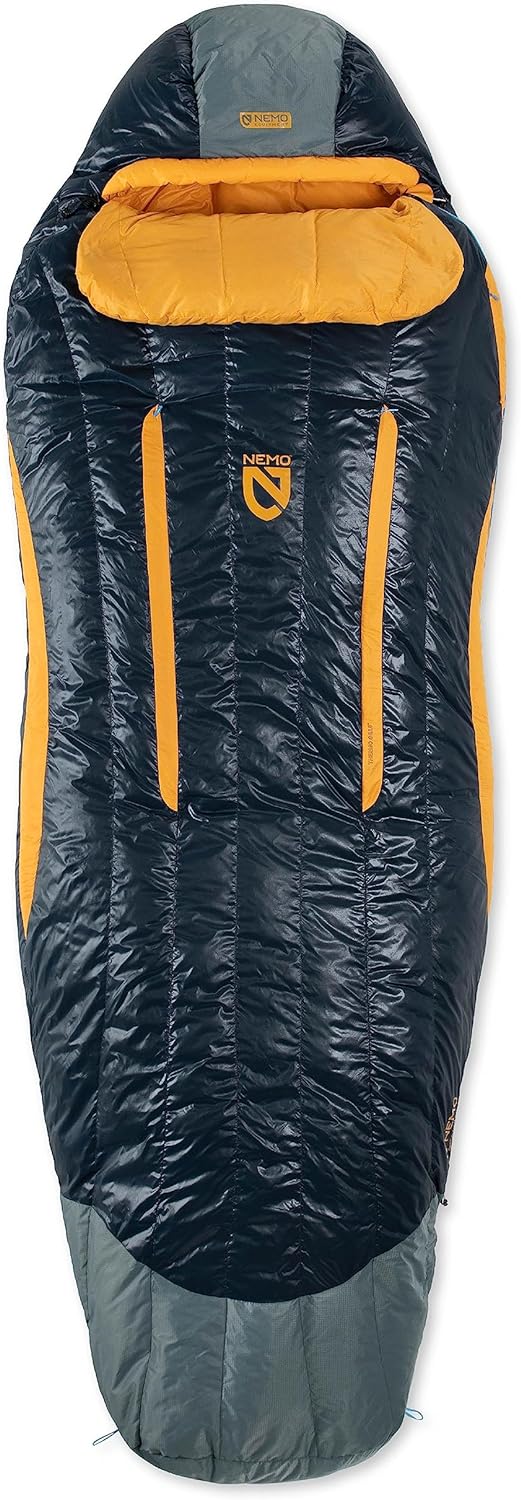
Nemo
This down sleeping bag is designed to bring you extra comforts for a reasonable weight; it offers a pillow pocket to keep your pillow from sliding around, as well as a blanket fold around your face to make the chilly nights feel a little more like home. The Disco 15, which is "spoon" shaped, has more legroom than a classic mummy bag. It comes with "gills," or vents that unzip to let heat out without letting the cold in for better temperature management. This sleeping bag comes in a few different temperature ratings to match your winter adventures, as well as both a men's and women's cut that zip together, so if you're going out in the winter with your partner, regardless of sex or gender I'd snag one of each of these bags to zip together so the cold doesn't have to keep you apart.
3. Sleeping Pad
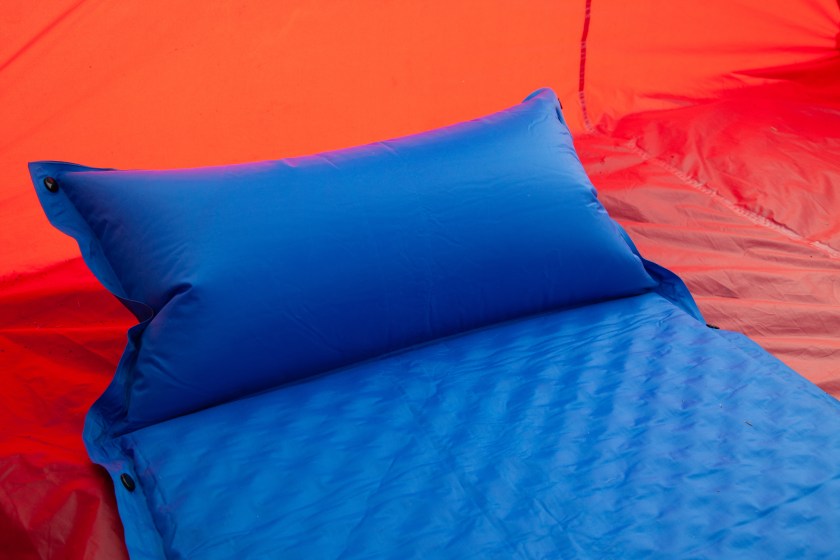
Getty Images, Ashley-Belle Burns
For winter camping, I'd recommend a minimum R-value of 5. If you're going out in extreme cold you may want to consider going much higher with the R-value of your sleeping pad. When I'm camping in the Arctic in -20 degrees, my setup has a combined R-value of 11. When I'm camping in near 0 temperatures, I wouldn't go any lower than a 7. You may have to try a few different setups to see how warm you prefer to sleep in different conditions.
You can also double-up on sleeping pads (I recommend using a closed-cell foam pad and an inflatable pad) to boost your warmth.
Our Top Picks
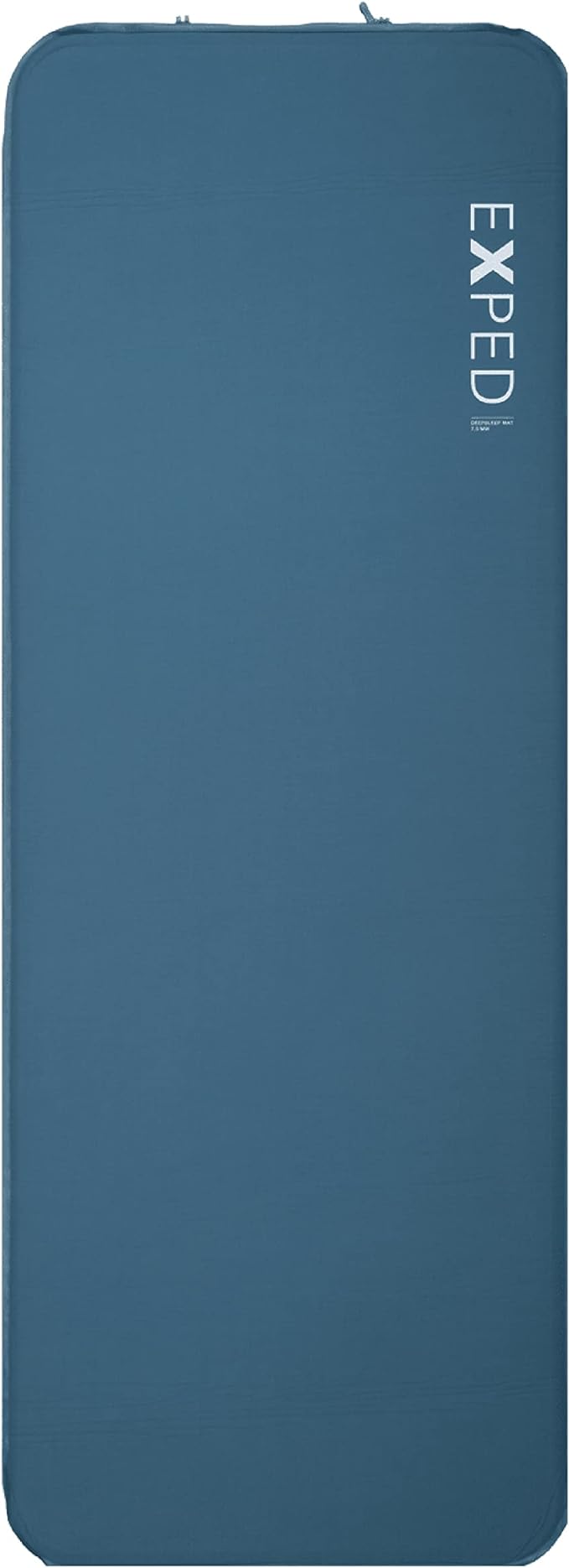
Exped
With an R-value of 9 but a heavier weight, this self-inflating sleeping pad is a great option for extreme cold or for car camping. It's incredibly comfortable and comes in a wide options for those who like to spread out while they're sleeping.
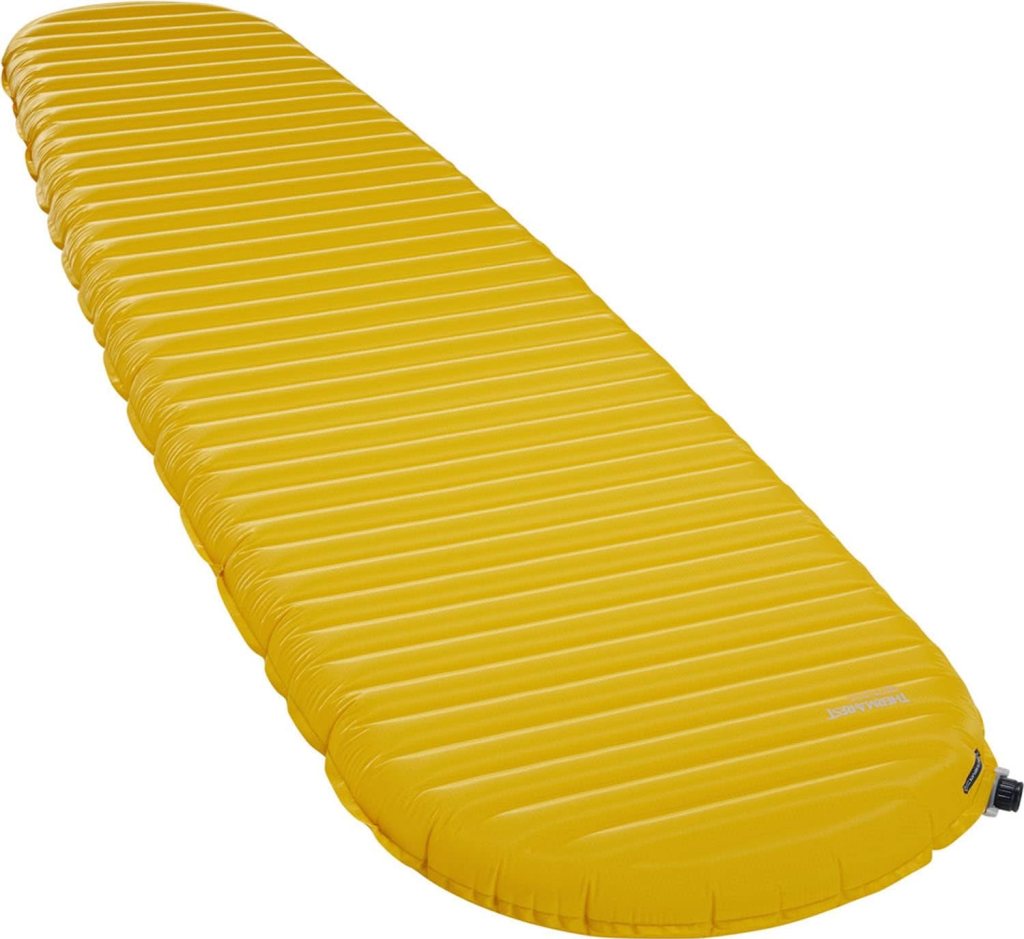
Therm-A-Rest
This all-season sleeping pad is ultralight, and when used in conjunction with a closed-cell foam pad, will provide a good night's sleep when camping in the cold. The NeoAir XLite has an R-value of 4.5 and this newest model is quieter when you move at night than older models.
4. Camp Stove
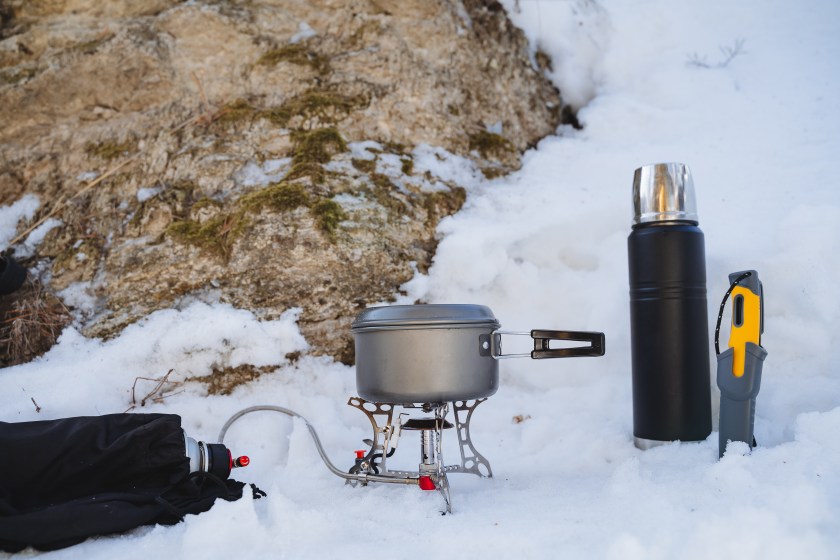
Getty Images, Aleksey Matrenin
For stoves with pumps (like the MSR XGK or Whisperlite), know that the pumps can freeze so you'll want to store the pump in a chest pocket or sleeping bag to keep it warm.
Our Top Picks
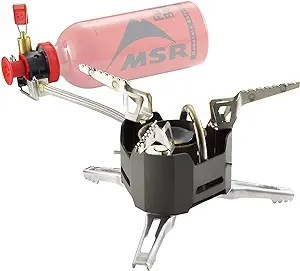
MSR
The XGK EK stove is an excellent choice for winter camping as it's reliable and can burn mutiple types of fuel, from white gas to jet fuel. It does include a pump you'll likely have to keep warm, but this stove is a solid choice if you're going out in the snow. The one con: It is pretty loud.
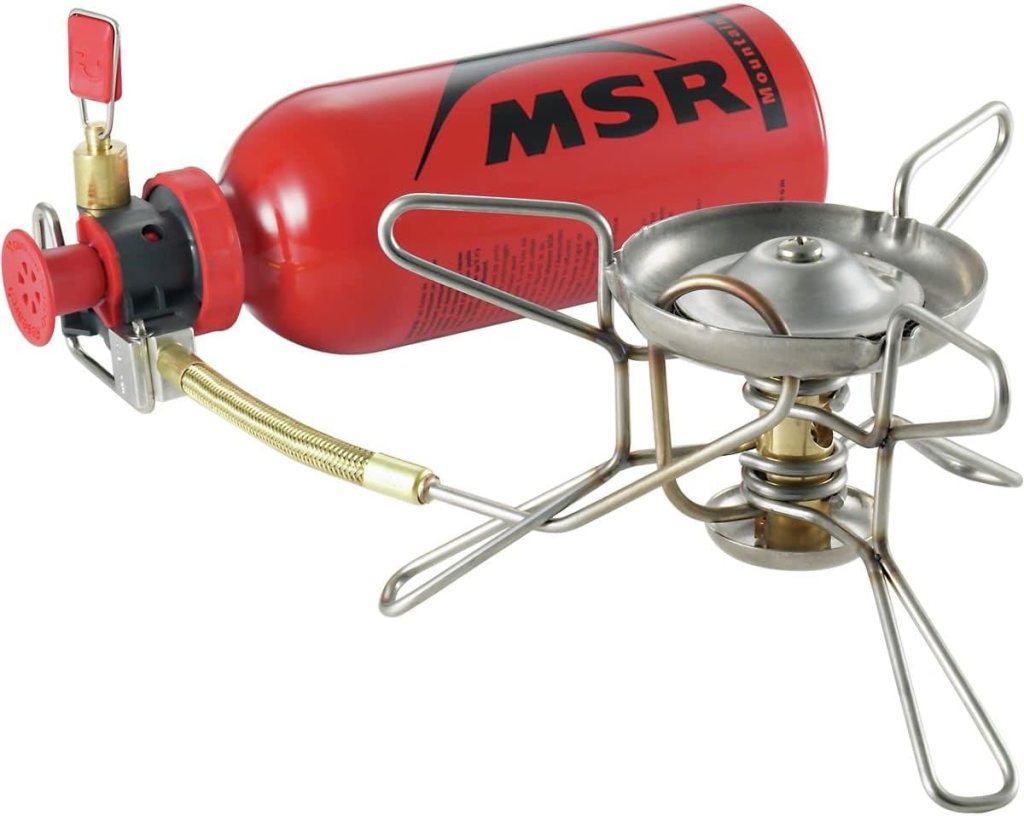
MSR
The Whisperlite is similar to the XGK EX (i.e., it uses a pump and is compatible with a variety of fuels), but it weighs a few ounces less. The Whisperlite works well, though it's slightly less sturdy than the XGK. Perhaps one of the most alluring features: It's pretty quiet for a stove with decent power.
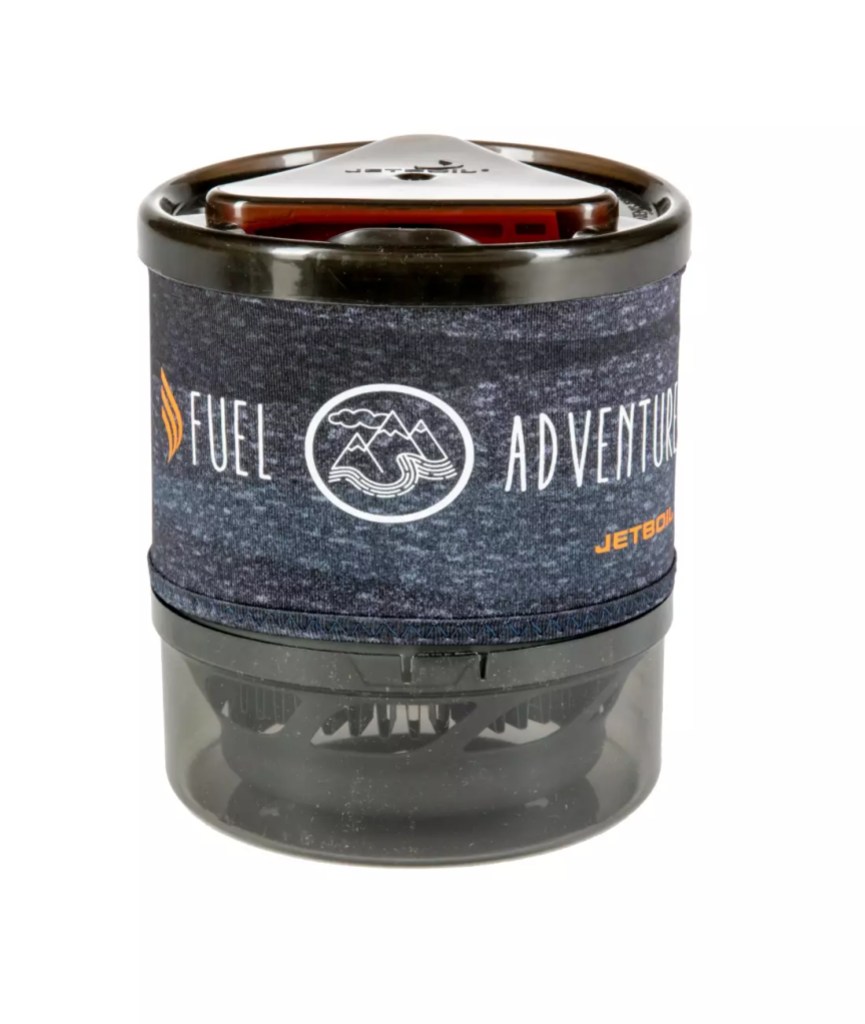 If you prefer a canister stove for ease of use or to have a single stove year-round, the Jetboil MiniMo is one of the best options. It's light, compact, and from a well-trusted brand, The MiniMo works well down to roughly 20 degrees Fahrenheit (not always true of other canister stoves), so while it's not ideal for extremely cold camping trips, it'll work well in all other instances.
If you prefer a canister stove for ease of use or to have a single stove year-round, the Jetboil MiniMo is one of the best options. It's light, compact, and from a well-trusted brand, The MiniMo works well down to roughly 20 degrees Fahrenheit (not always true of other canister stoves), so while it's not ideal for extremely cold camping trips, it'll work well in all other instances.
5. Sleeping Layers
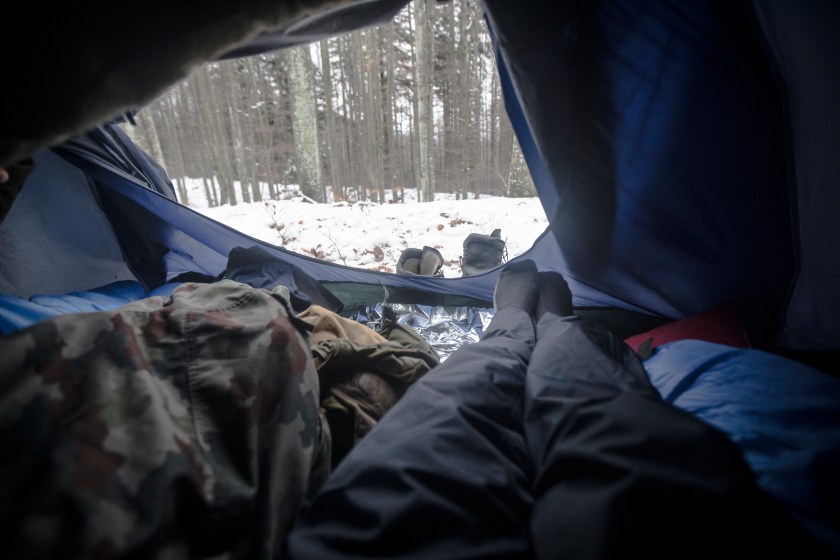
Getty Images, kmatija
Having a pair of dedicated sleeping layers that aren't grimey from dried sweat and dirt can make a huge difference in your sleep quality. Aim for technical, warm, drying materials but most of all, aim for max comfort.
Pro tip: Keep your sleeping layers in a separate ziploc or stuff sack in your pack or sled; that way, they're ready to go when you get to camp.
Our Top Picks
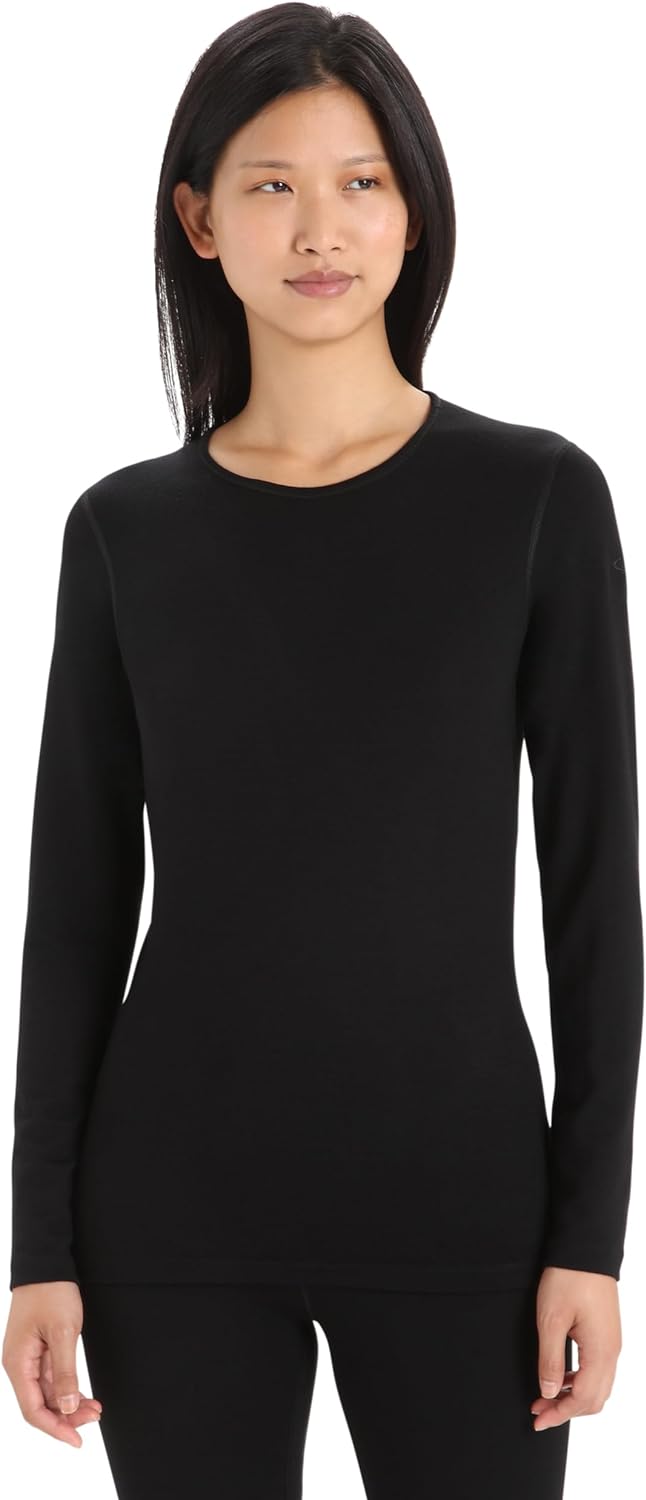
Icebreaker
A wool base/midlayer with a weight of 260 or higher is a great sleep layer for cold camping. A higher number will keep you warmer, and merino wool is soft and comfortable on the skin. There are a lot of great brands out there that can provide this, but Icebreaker is my top choice, providing quality products that last and perform.
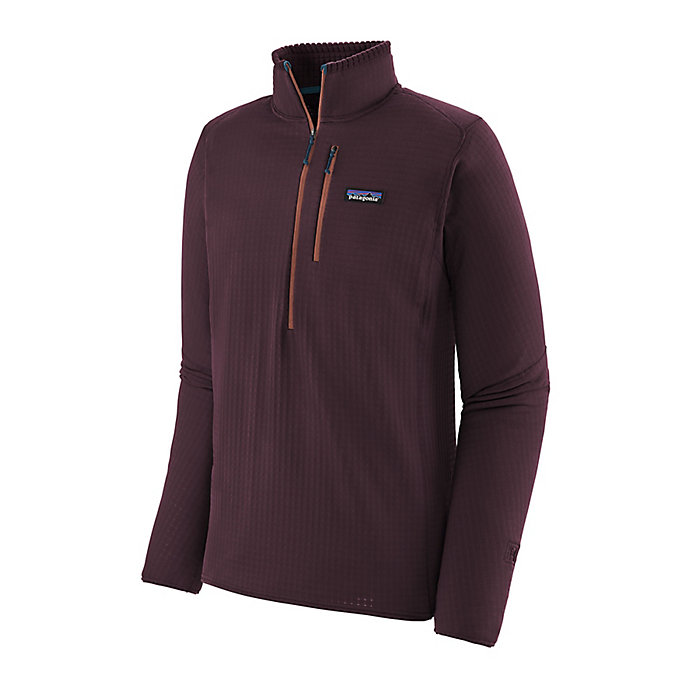
Patagonia
I never go out into the wilderness without this midlayer, and it has kept me warm all around the globe. The fleece pullover is both soft and breathable and has a chest pocket big enough for your phone so the device's battery doesn't drain at night and the alarm will still wake you up. The tops come in a few different styles and there are pants to match.
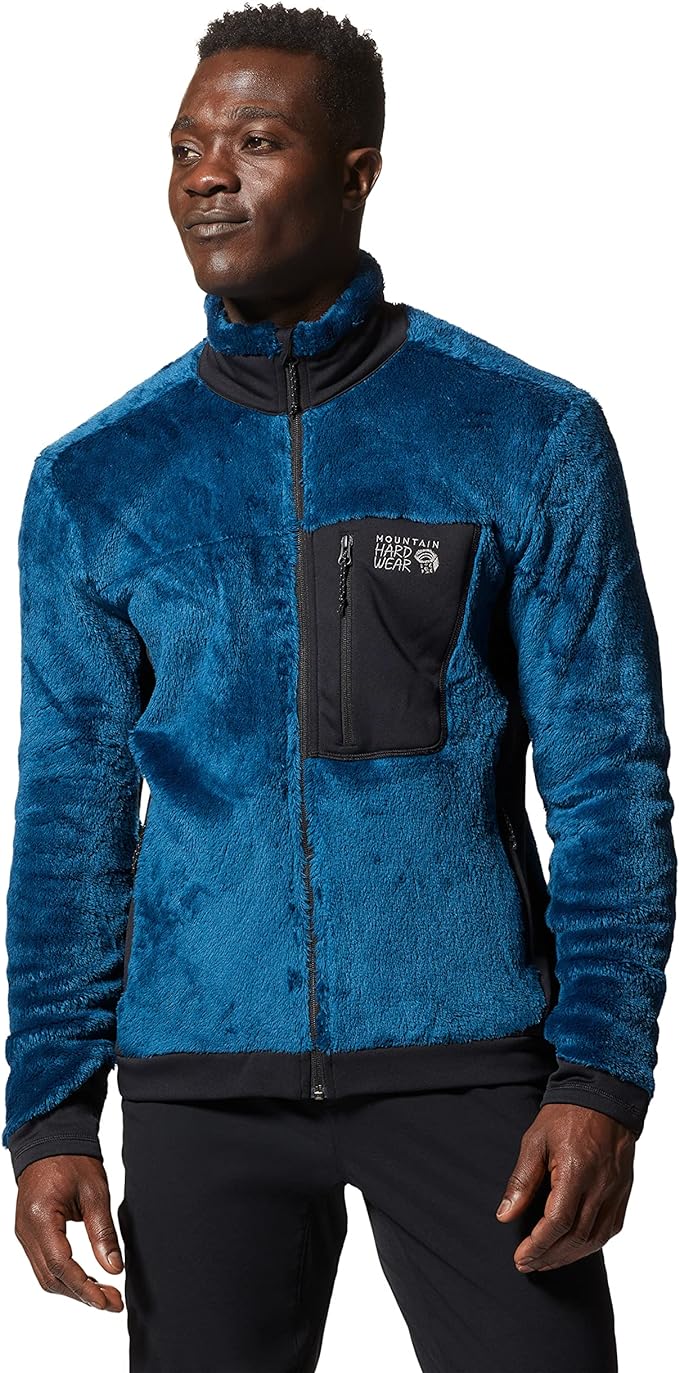
Mountain Hardware
Polartec fleece is an amazing material for keeping warm in winter. Mountain Hardwear's fleece set (jacket and pants) are very comfortable for sleeping and both have zip pockets. One thing to note is that snow does stick to the fleece a little, so these should remain in-tent use. But they are comfy and warm and will have you feeling cozy in the cold.
6. Other Gear Considerations
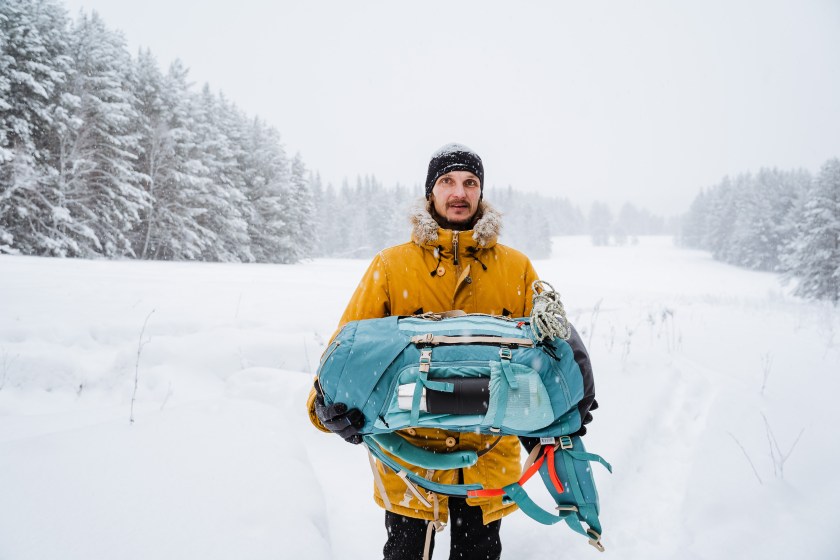
Getty Images, Aleksey Matrenin
- Snowshoes, skis, or a splitboard if you're backpacking, in order to get to where you're camping.
- A large backpack or sled, harness, and rope to haul all your heavy winter gear, layers, and extra fuel.
- A shovel, regardless of if you're car camping or backpacking. This will be invaluable to dig out your tent if the snow piles up. Plus, you can dig out a kitchen pit in your vestibule, or a toilet, or build a snow wall if conditions are really uncomfortable.
- A headlamp, since with winter comes shorter days.
- A pee bottle, potentially, so you don't have to leave the tent in the middle of the night. Just make sure to mark this bottle to avoid any confusion with your drinking bottle.
- Extra food and fuel since both you and your stove might need more energy in the cold weather.
- Power banks to charge your phone and satellite device, at the very least, since electronics lose power quickly in the cold.
- Emergency equipment is always important, but may be even more important in winter. Make sure your first aid kit is stocked well, and it doesn't hurt to throw in a few packs of hand warmers and toe warmers for quick heat if you find yourself getting really cold.
Tips for How to Stay Warm Camping on a Cold Night
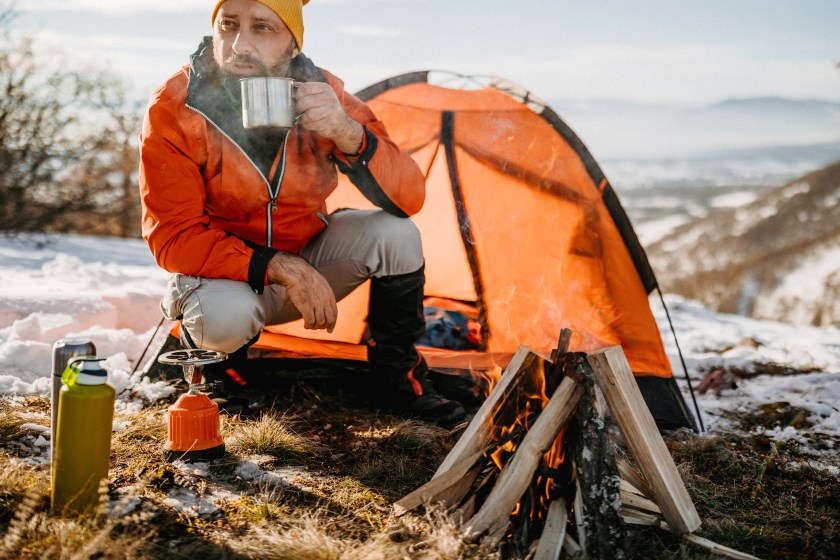
Getty Images, mixetto
1. Make a Hot Water Bottle for Your Sleeping Bag
I'm convinced that Nalgenes are a secret weapon to absolutely thrive in any condition outdoors, but they are especially handy in the winter as, once filled with hot water, they can act as a radiator in your sleeping bag at night.
It's simple: You just fill a Nalgene with near-boiling water and drop it into your sleeping bag. Often, the Nalgene is too hot to hold at the start, but it preheats your bag before you climb in and, since it slowly loses heat over time, often when you're ready to climb in, you can cuddle with the warm bottle or keep it at your feet for an excellent distribution of warmth.
I always use at least two bottles (and sometimes three, if the conditions are seriously cold). You can also get an insulated cover to slide the Nalgene into to make the heat last longer throughout the night.
2. Change Out of Sweaty Clothes
Even in the cold, if your body is working, you are going to sweat. That means when you roll into camp after a long day of skiing, snowshoeing, or hiking, your base layers will likely be wet. Once you stop moving and your body cools down, that moisture will make you chilled to the bone, really fast.
Change out of those sweaty clothes and into some dry clothes ASAP, and then all the heat your body produces will keep you warm instead of working to dry your clothes.
3. Use Two Sleeping Pads
Your sleeping pad is a critical piece of camping gear for keeping you warm on cold winter nights. It's there to fill in the literal gap between your body and the ground, and keep the cold earth from stealing your body heat.
Sleeping pads are rated with an "R-value," which is how well the pad resists heat flow through it—basically how warm the pad will keep you. Using two pads—one closed-cell foam and one inflatable—is a quick, easy, and cost effective way to insulate your body a bit more from the cold.
When using two pads, adding the R-values together will give you the total R-value of your kit. Aim for a total insulation of at least 5, but ideally at least a 7 for extremely cold temperatures.
4. Eat Before Bed
At night, as your regular body processes slow down, your body temperature drops. Digestion raises your body temperature, so eating before bed gives your body fuel to keep you well-heated through the night. Take in protein and fat before bed, which require a longer amount of time for your body to process than carbs.
This doesn't mean you have to eat a bag of beef jerky right before you go to sleep (though you certainly can). Simply, your dinner should contain a solid dose of protein and fat, especially since these macronutrients are a little less common in the quick-and-easy snack foods we often eat in the backcountry.
And don't skip dessert—chocolate is a great source of fat that will keep your tastebuds happy, your morale up, and your sleeping bag warm.
5. Get Warm Before Getting In Your Sleeping Bag
Sleeping bags work by trapping the air around your body and keeping it from moving or escaping so it can maintain its temperature. The heat source isn't actually the sleeping bag, it's you. If you can crawl into your sleeping bag already warm, you'll start your night off much warmer, making it easier to stay warm through the night.
Layering up with dry, insulated clothes around camp will help you feel plenty warm when it's time to go to bed. A little bit of movement can also help warm your body and give your sleeping bag heat to reflect back at you—try sit ups, a few quick jumping jacks outside your tent, or, my personal favorite, doing a plank before crawling into your cocoon.
How Cold Is Too Cold to Winter Camp?
Surprisingly, there isn't a hard-and-fast rule on when temperatures are too low to safely camp. It's very subjective based on personal comfort, personal physiology, and the gear you're using to stay warm. For some people, a 20-degree sleeping bag and a three-season tent are warm enough, even if there are high winds and snow in the forecast. For others, the same conditions would require a 0 degree bag, a four-season tent, and more insulated clothing.
I've camped in the snow when it's above freezing and I've camped in Antarctica at below -90 degrees. And while it's possible to camp at -90, I wouldn't recommend it; it was pretty uncomfortable and took a lot of extra work to be warm enough to sleep a little.
In my opinion, between your camping gear and your experience level, if you can't stay warm enough to sleep reasonably well (I'm talking: not spending the whole night shivering), it's probably too cold to be out camping.
The main worry here is cold injuries, namely frostbite and hypothermia.
The best way to prevent cold injuries are:
- Protect exposed skin in cold weather, especially if there's wind.
- Have gear rated for the conditions you'll be in.
- Regularly check your skin and your friends' skin for signs of cold damage (namely white patches on skin, especially with a waxy appearance).
- Stay well-fed and hydrated.
- Wear necessary amounts and types of layers, and adjust them as needed so you're warm but not sweating.
- Layer up when you're not moving to retain your body heat. In particular, keep your core warm.
- If you start to feel cold, move. Skiing, snowshoeing, waving your arms back and forth, jumping jacks, running around for a couple minutes—any movement should warm up within 20 minutes or so.
- If you can't get warm, it's no longer safe to be out in these conditions. This might mean putting up the tent, making a warm meal, and crawling into your sleeping bag, and if that doesn't work it might mean heading back to the car and ending your trip.
Who We Are
Alyssa Whoaa, with multiple seasons living in Antarctica many-a cross-country skiing expedition under her belt, has extensive winter camping experience and has tested a lot of gear in various winter conditions. Alyssa has hiked the Pacific Crest Trail in a high snow year, participated in polar trainings in the mountains and on sea ice, completed lengthy polar expeditions in the Arctic and Greenland, finished three marathons in Antarctica, camped in these cold environments and plenty of others, and participated in outdoor activities in temperatures as cold as -100 degrees Fahrenheit. With a combined total of over two years of icy experience in a variety of extremely cold conditions, Alyssa knows her way around the winter.
Wide Open Spaces has been providing honest and thorough advice on getting outdoors for nearly 15 years. Our team of writers and editors are out in the field (and streams, and mountains) putting the gear new and old to the test.
READ MORE: 9 Things That Will Keep You Alive This Winter in the Backcountry
